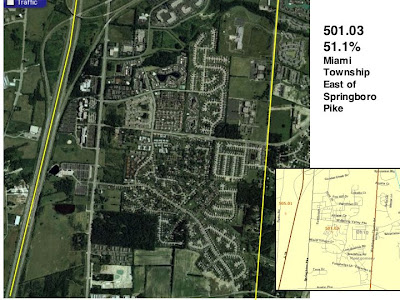The census has a 100 percent count for basic demographic information like race, sex, and age, so one can build some stats to show how many people 21 and up are in a census tract, and also how many are in the 21-34 category (the one I use for young adults), both as % and as total county.
Graphing these out by census tract, highest to lowest % of young adult 21-34, one sees top tracts are for Wright-Patterson (military living on-base) and University of Dayton (the UD “student ghetto” plus Fairgrounds neighborhood), followed by some secondary clusters, a mid range, and then a drop-off
 Mapping the top tracts, one sees the top four percentage tracts out in the suburbs, some inner ring tracts (Kettering east of Oakwood and but two tracts in the city comprising Shroyer Park, Walnut Hills ,and Ohmer Park. But there seems to be a pretty strong concentration in East Dayton for lower percentages, too. East Dayton seems to have quite a density of the 21-34 cohort
Mapping the top tracts, one sees the top four percentage tracts out in the suburbs, some inner ring tracts (Kettering east of Oakwood and but two tracts in the city comprising Shroyer Park, Walnut Hills ,and Ohmer Park. But there seems to be a pretty strong concentration in East Dayton for lower percentages, too. East Dayton seems to have quite a density of the 21-34 cohort Looking at absolute numbers, the top tracts aside from UD and the base are clustered in the south suburbs, south of I-675, on either side of I-75.
Looking at absolute numbers, the top tracts aside from UD and the base are clustered in the south suburbs, south of I-675, on either side of I-75. What it Looks Like
What it Looks LikeTaking a look at the top suburban tracts, what they look like from the air, and on the ground. Lots of apartment/condo clusters in these tracts, and in 501.03 some brand new starter home plats.
501.03 bears some further study as it has some early –mid 1970s multifamily, an era where the “woodsy shedsy” ski lodge style was popular. Also perhaps early examples of Planned Unit Development.

Multifamily with Corporate presence in the background. If one worked at Lexis-Nexis or Newmark one could walk or bike to work.
 Tract 218 has a concentration of subsidized housing but also some nicer modern apartments.
Tract 218 has a concentration of subsidized housing but also some nicer modern apartments.
 This tract is up on the hills climbing out of the Miami Valley, so one glimpses some nice views on occasion. It’s mostly 1970s multi-famliy, with some single family out along “King Richard”. Part of West Carollton.
This tract is up on the hills climbing out of the Miami Valley, so one glimpses some nice views on occasion. It’s mostly 1970s multi-famliy, with some single family out along “King Richard”. Part of West Carollton. 
Except for this complex.
“Centerville Park” (pretty far from Centerville, actually) was the first apartment complex along OH 725. Bilt in the mid 1960s, it pre-dated the Dayton Mall, and most of the suburban development between Miamisburg and Centerville. Maybe a historic designation is in order? It's 40 years old or older.
 Probably 1970s housing. There's actually a lot of convenience shopping close buy. Theoretically walkable, but I'll bet no one does (note the walkway or bikeway running in front of the units, left to right)
Probably 1970s housing. There's actually a lot of convenience shopping close buy. Theoretically walkable, but I'll bet no one does (note the walkway or bikeway running in front of the units, left to right) This tract is the old Village of Riverside, Overlook, and some other stuff. The concentration here in at the huge apartment complex in the heart of Riverside, built to replace WWII temporary housing.
This tract is the old Village of Riverside, Overlook, and some other stuff. The concentration here in at the huge apartment complex in the heart of Riverside, built to replace WWII temporary housing.
 We'll take a closer look at the Dayton high % /high # tracts later, particularly Woodland Hills and Shroyer Park.
We'll take a closer look at the Dayton high % /high # tracts later, particularly Woodland Hills and Shroyer Park. But it seems for suburbia, for 20 and 30-something neighborhoods, one is looking at suburban apartments and condos, and maybe some starter-home plats. I didnt show Tract 301, which is also a top concentration, but it is not much different from whats shown above, except two trailer parks appear as concentrations for 21-34, as well as apartment complexes.
Maybe I need to get on subsidized housing. Some of those places look pretty decent.
ReplyDeleteNone of these pix are subsidized. There is subsidized housing in Tract 18, but I didnt post pix of it. I have a thread on that over at Urban Ohio, I think.
ReplyDelete